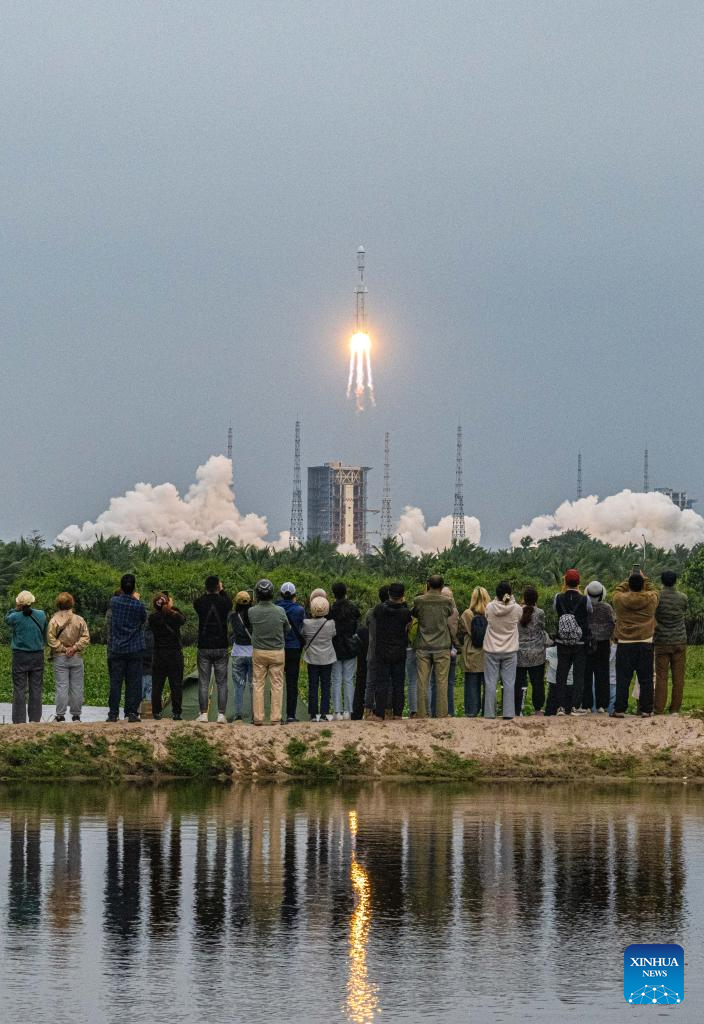
A Long March-8 rocket, carrying the relay satellite Queqiao-2 for Earth-Moon communications blasts off at the Wenchang Space Launch Center in south China's Hainan Province, March 20, 2024. (Xinhua/Yang Guanyu)
WENCHANG, Hainan, March 20 (Xinhua) -- China launched a new relay satellite on Wednesday to provide Earth-Moon communications services, a key step for its future lunar exploration missions such as retrieving samples from the far side of the moon.
A Long March-8 rocket, carrying the satellite dubbed Queqiao-2, or magpie bridge-2, soared into the sky at 8:31 a.m. from the Wenchang Space Launch Site in south China's Hainan Province.
After 24 minutes of flight, the satellite separated from the rocket, and entered the planned Earth-Moon transfer orbit with the perigee at 200 kilometers and the apogee at 420,000 kilometers. The satellite's solar panels and communications antennae were unfolded, according to the China National Space Administration. ■

A Long March-8 rocket, carrying the relay satellite Queqiao-2 for Earth-Moon communications blasts off at the Wenchang Space Launch Center in south China's Hainan Province, March 20, 2024. (Xinhua/Yang Guanyu)

A Long March-8 rocket, carrying the relay satellite Queqiao-2 for Earth-Moon communications, blasts off at the Wenchang Space Launch Center in south China's Hainan Province, March 20, 2024. After 24 minutes of flight, the satellite separated from the rocket, and entered the planned Earth-Moon transfer orbit with the perigee at 200 kilometers and the apogee at 420,000 kilometers. The satellite's solar panels and communications antennae were unfolded, according to the China National Space Administration. (Xinhua/Yang Guanyu)

A Long March-8 rocket, carrying the relay satellite Queqiao-2 for Earth-Moon communications, blasts off at the Wenchang Space Launch Center in south China's Hainan Province, March 20, 2024. After 24 minutes of flight, the satellite separated from the rocket, and entered the planned Earth-Moon transfer orbit with the perigee at 200 kilometers and the apogee at 420,000 kilometers. The satellite's solar panels and communications antennae were unfolded, according to the China National Space Administration. (Xinhua/Pu Xiaoxu)

A Long March-8 rocket, carrying the relay satellite Queqiao-2 for Earth-Moon communications, blasts off at the Wenchang Space Launch Center in south China's Hainan Province, March 20, 2024. After 24 minutes of flight, the satellite separated from the rocket, and entered the planned Earth-Moon transfer orbit with the perigee at 200 kilometers and the apogee at 420,000 kilometers. The satellite's solar panels and communications antennae were unfolded, according to the China National Space Administration. (Xinhua/Pu Xiaoxu)

A Long March-8 rocket, carrying the relay satellite Queqiao-2 for Earth-Moon communications, blasts off at the Wenchang Space Launch Center in south China's Hainan Province, March 20, 2024. After 24 minutes of flight, the satellite separated from the rocket, and entered the planned Earth-Moon transfer orbit with the perigee at 200 kilometers and the apogee at 420,000 kilometers. The satellite's solar panels and communications antennae were unfolded, according to the China National Space Administration. (Xinhua/Pu Xiaoxu)

A Long March-8 rocket, carrying the relay satellite Queqiao-2 for Earth-Moon communications, blasts off at the Wenchang Space Launch Center in south China's Hainan Province, March 20, 2024. After 24 minutes of flight, the satellite separated from the rocket, and entered the planned Earth-Moon transfer orbit with the perigee at 200 kilometers and the apogee at 420,000 kilometers. The satellite's solar panels and communications antennae were unfolded, according to the China National Space Administration. (Xinhua/Pu Xiaoxu)

A Long March-8 rocket, carrying the relay satellite Queqiao-2 for Earth-Moon communications, blasts off at the Wenchang Space Launch Center in south China's Hainan Province, March 20, 2024. After 24 minutes of flight, the satellite separated from the rocket, and entered the planned Earth-Moon transfer orbit with the perigee at 200 kilometers and the apogee at 420,000 kilometers. The satellite's solar panels and communications antennae were unfolded, according to the China National Space Administration. (Xinhua/Yang Guanyu)

A Long March-8 rocket, carrying the relay satellite Queqiao-2 for Earth-Moon communications, blasts off at the Wenchang Space Launch Center in south China's Hainan Province, March 20, 2024. After 24 minutes of flight, the satellite separated from the rocket, and entered the planned Earth-Moon transfer orbit with the perigee at 200 kilometers and the apogee at 420,000 kilometers. The satellite's solar panels and communications antennae were unfolded, according to the China National Space Administration. (Xinhua/Yang Guanyu)
信息網(wǎng)絡(luò)傳播視聽節(jié)目許可證:120330032
中華人民共和國互聯(lián)網(wǎng)新聞信息服務(wù)許可證:45120170002
中華人民共和國互聯(lián)網(wǎng)出版許可證 (署)網(wǎng)出證(桂)字第020號(hào)
廣播電視節(jié)目制作經(jīng)營許可證編號(hào):(桂)字第0230號(hào)
網(wǎng)警備案號(hào):45010302000253
桂ICP備11003557 南寧新聞網(wǎng)版權(quán)所有
舉報(bào)電話:0771—5530647 郵箱:mail@nnnews.net
登錄
還沒賬號(hào)?立即注冊(cè)
點(diǎn)擊頭像快速登錄
請(qǐng)輸入驗(yàn)證碼